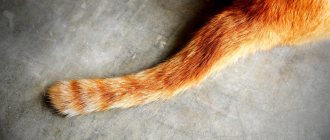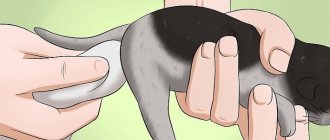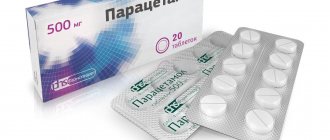Cats have been known mousecatchers since their domestication. Some individuals are so good at catching rodents that they are able to completely rid both the house and the surrounding area of them. It is not surprising that rat poisoning in cats is one of the main dangers that can await your pet. You need to clearly know the main types and principles of action of the poison, since in this case the chances of saving the cat’s life increase sharply.
Basic information
The most common poisons today are those whose operating principle is based on a disorder of blood clotting, causing a mouse that eats a poisoned bait to die from internal bleeding. The most commonly used bases are: Brodifacoum, Difacion, Warfarin and Bromadiolone. These are very effective anticoagulants. Please note: in most cases, rat poisons containing these substances are green in color. This is necessary for pet owners, since cats themselves do not see shades of green.
When this poison enters a cat's body, it destroys vitamin K and blocks blood clotting mechanisms. It should be noted that manufacturers of deratization products try to select the dose of poison so that a cat or dog that accidentally eats it does not immediately bleed to death, so that the owner has enough time to call a veterinarian and administer an antidote. However, if your pet gets hold of the package of poison, this rule will not work.
Important! If your cat has eaten mouse poison, do not let him drink it under any circumstances! If the dose was large, it will immediately develop internal bleeding, from which the animal will die.
By the way, how are cats poisoned by poisons intended to kill rats? Judging by research by veterinarians and pest control companies, more than 90% of cases occur when cats eat poisoned rodents. As you might guess, the poison does not have time to be eliminated from the body of a mouse or rat, which is why the cat that eats it also receives a loading dose of poison. Much less often, animals eat the rodent killer directly, or pick up poisoned bait accidentally or intentionally left on the street.
Poisoning with rat poison
Is it very scary? Is it different from ordinary poisoning? Yes! and YES!
A cat can be poisoned by rat poison in two ways:
- By eating the poison itself (direct). Rodent baits have a pleasant taste, which makes them attractive not only to direct consumers, but also to dogs and cats.
- Eating a poisoned rodent (indirect). A poisoned rat or mouse, weakening, becomes easy prey for a cat. Modern means are very effective, so the portion of poison that enters the rodent’s body will be sufficient for a larger animal.
Rat killing products use rodenticides containing different active ingredients - coumarin, indandione, etc., therefore their effects on the body are different.
But most often cats suffer from anticoagulant rodenticides. We will consider them. Anticoagulants are chemical substances that prevent blood from stopping. Anticoagulant poisons contain coumarin: zoocoumarin, warfarin, flomucafen, coumatetralyl, bromodiolon, brodifacoum.
Other types of poisonous agents
It should be remembered that there are currently other types of rodent control agents on the market, not all of which are based on substances that prevent blood clotting. In particular, drugs based on... ordinary vitamin D3 are considered a very dangerous variety. How does it work?
The fact is that with an overdose of this substance in the blood plasma, the concentration of calcium and phosphorus sharply increases. This is very dangerous for the kidneys. A cat that has eaten a poisoned rodent will quickly develop signs of kidney failure. This includes edema, uremia, etc. If the animal is not taken to a veterinary clinic as soon as possible, it will either die or remain disabled for life. The longer you wait to see a veterinarian, the worse it gets. Remember that once a clinical picture of renal failure appears, there is no longer a chance for your pet to fully recover. The consequences are so severe that they condemn the animal to a lifelong “sitting” on medications.
Actions to take if poisoned by rat poison:
First , try to immediately induce vomiting in your pet. This will reduce the possibility of the poison being absorbed by the stomach and its further spread throughout the body. How to do it? It is advisable to use ipecac root syrup (emetic root), approximately 4 ml per average cat, in extreme cases, use 3% hydrogen peroxide, 1 teaspoon per 5 kg of weight. Sometimes it is possible to induce vomiting by giving the animal a large amount of boiled water and pressing on the root of its tongue.
But! This measure is effective if the poison was eaten recently. It makes no sense to induce vomiting in a cat after a few hours or when signs of poisoning appear, since the poison has already been absorbed by the gastrointestinal tract.
Secondly , give your pet an adsorbent (it doesn’t matter whether you managed to induce vomiting or not): activated carbon (1 tablet per 1 kg of weight, crushed, diluted in water and given to drink), enterosgel, enterosorb, etc.
Thirdly , apply an antidote! To restore the blood clotting mechanism, an injection of vitamin K1 is required.
Now about vitamin K1 Vitamin K1 (phylloquinone, phytomenadione) is a fat-soluble vitamin necessary to restore blood clotting function.
Vitamin K1 has a coagulation effect; it increases blood clotting, strengthens the walls of blood vessels and reduces their bleeding.
There is veterinary vitamin K1 (Veta-K1, Veda-K1, Mephyton, Aqua-Mephyton), but, unfortunately, it can only be purchased abroad.
Therefore, the best option would be to use such human drugs as Vitamin K1, Eleven K, Fimediod, Phytonadion, Konakion, Konavit, Mefiton, Monodion, L-Phylloquinone. The funds are expensive, but necessary.
Unfortunately, Vitamin K1 is not available in all clinics and, especially, not in all home medicine cabinets. It is often replaced with vitamin K3 (Menadion, Vikasol) - a water-soluble synthetic analogue.
But! Vikasol is ineffective for coumarin poisoning; it is not able to replenish the necessary supply of vitamin K, and in high doses it can cause liver damage. Of course, if there is no way to get Vitamin K1, then out of desperation you can use Vicasol.
Precautionary measures
It just so happens that cats are predators, and eating rodents is a natural behavior for them. Accordingly, they will always be at risk; it is very difficult to prevent cases of poisoning. Perhaps the most protected are cats living in city apartments, but even in this case it is possible that poisoned rodents may enter the house (during mass deratization).
So here everything depends on the vigilance and attentiveness of the animal’s owners. If you hear that your area will be treated for rats and mice (and by law, the sanitary and epidemiological station is required to warn about this), do not let your cat go outside. If you notice something strange in your pet's behavior, immediately take him to the veterinarian: it is possible that he has already eaten a poisoned rodent. Always have a supply of activated carbon at home, with which you can provide first aid to your cat in case of poisoning.
Important! Be sure to try to find packaging or samples of the poison. This will help in prescribing adequate therapy.
Symptoms of rat poison poisoning in cats
If a cat is poisoned by rat poison based on zoocoumarins, the symptoms will be as follows:
- Bleeding from the nose, the appearance of blood in stool and urine, hemorrhages on the gums. These signs develop within 1 to 10 days after the poison enters the body.
- Vomiting may occur, but is not necessary. Occurs after eating bait or a rodent.
- The cat may die within a few days without obvious signs as a result of internal bleeding.
- If such poisons are used in your area, then dead rodents will leak uncoagulated blood from the mouth or anus.
If you eat bait containing drugs from other groups, cats will have different symptoms if they are poisoned by rat poison:
- excitement, nervousness, increased motor activity;
- lack of coordination: paws become entangled, the animal falls to the side, cannot stand up, shakes its head;
- muscle tremors, convulsions, involuntary twitching of limbs;
- increase in body temperature.
- lethargy, drowsiness.
Clinical picture
If a cat is poisoned by rat poison, symptoms usually appear within 24 hours. There are times when symptoms may be absent or appear after a few days.
Symptoms of cat poisoning by rat poison:
- apathy;
- difficulty breathing, cough;
- nosebleeds, blood in stool;
- red eyes (if blood vessels burst);
- bloating (a possible sign of internal bleeding);
- vomiting, diarrhea;
- joint inflammation.
Such symptoms of rat poisoning in cats appear if the animal has eaten bait with poison from the group of zoocoumarins. If the cat's owner notices signs of toxin poisoning, it is necessary to immediately contact a specialist - the animal may die without timely veterinary care.
Depending on the type of poison, symptoms may be different:
- severe hyperthermia;
- when walking, the animal’s legs may become tangled;
- convulsions, nervousness;
- lack of coordination - the cat falls on its side;
- drowsiness, lethargy.
It is important to remember that all signs of poisoning will not appear at the same time. It is necessary to pay attention to any changes in the behavior of your pet. If your cat has been poisoned by rat poison and the symptoms appear suddenly, do not panic! Call a veterinarian, and until a specialist arrives, provide first aid to the animal.
If a cat has been poisoned by rat poison, the owner needs to help the pet survive until the veterinarian arrives. It is necessary not to panic, soberly assess the situation and draw up an action plan.
There is an opinion that if a cat is poisoned by rat poison, then it is necessary to induce vomiting in the pet in order to cleanse the body of the toxin. But you should do this only if the owner of the animal is sure that the cat was poisoned recently, almost before his eyes. If the poison has been circulating in the blood for a long time, vomiting will lead to dehydration and make the situation even worse. To prepare a solution to induce a gag reflex, mix hydrogen peroxide (3%) with water in a 1:1 ratio at the rate of 1 tsp. liquid per 2 kg of cat weight. For the same purpose, you can give the animal salt water.
Oil is poured into a cat through a syringe
To prevent the spread of the toxin throughout the body, activated carbon or other sorbents are given. To prevent the poison from getting into the blood, after the vomiting has completely stopped, the animal is given milk, egg white diluted in water, and a decoction of flax seeds. After a few hours, it is necessary to cleanse the intestines. For this purpose, you can give the cat castor or vaseline oil or use an enema. If a cat is poisoned by rodent poison, the actions listed above will save the animal’s life.
If the owner did not panic and did everything correctly, veterinarians will only have to administer an antidote - in case the cat was poisoned by a poison from the group of zoocoumarins. In medicine, regular vitamin K (Vikasol) is used. Treatment can last from several weeks to a month. The decision to discontinue a course of medication must be made by a veterinarian.
Tips for caring for a sick animal
Proper care in the recovery process plays no less a role than correctly selected drug treatment. The cat owner needs to be patient, since after poisoning the animal may have no appetite for a long time. In this case, droppers are used.
Some tips on what to do if your cat is poisoned by rat poison:
- The first day you cannot feed the animal. Just give more clean drinking water.
- After 24 hours, dietary foods (lean meat, fish, rice, boiled vegetables) are introduced into the diet.
- Allow the animal to rest and gain strength.
If your cat is poisoned by rat poison, do not try to deal with the problem yourself. Only a veterinarian, having examined the animal and recorded the symptoms, can say exactly how and with what the animal should be treated in each specific case, because zoocoumarin is not the only possible rat poison.
The cat may eat potassium cyanide or be poisoned by regular vitamin D. In these cases, symptomatic treatment is necessary, which is impossible at home. When vitamin D poisoning occurs, the animal develops kidney problems, the cat becomes lethargic, and often goes to the toilet. In the case of potassium cyanide, cerebral edema is possible. With the right therapeutic approach, everything will end well for the cat, but it is difficult for the average person to distinguish the symptoms of poisoning by a particular toxin, so the help of a specialist is needed.
Treating a cat for rat poisoning
If your cat shows signs of rat poison poisoning, you should not self-medicate; call or take the animal to the veterinarian! As a rule, symptoms mean that the poison has already been completely absorbed into the blood and affects the body for quite a long time. Qualified veterinary care will be required:
- administration of an antidote;
- symptomatic and supportive therapy;
- intravenous drip administration of drugs.
First aid
But before the doctor arrives, you can give your cat first aid.
- It makes sense to induce vomiting if the animal has eaten suspicious food in front of you. Otherwise, the poison has already been absorbed into the blood, and the procedure, instead of helping, can cause harm - lead to dehydration of the body. In order for a cat to vomit, she is given a 3% solution of hydrogen peroxide diluted in water (in a 1:1 ratio) at the rate of 1 teaspoon per 2 kg of body weight. Or use a saturated solution of table salt. Approximately 2-3 tablespoons are forcibly poured from a spoon or syringe without a needle per adult animal. You can also place a small piece of baking soda on the root of your tongue.
- To bind the poison in the stomach, give a suspension of activated carbon or any adsorbent from the first aid kit: Polysorb MP, Enterosgel, Polyphepan and the like. The adsorbent is diluted in warm water and poured into the mouth in an amount of about 100 ml.
- To prevent the poison from being absorbed from the intestines into the blood, enveloping mucous solutions are given: egg white diluted with water; milk, starch paste, flax seed decoction. The adsorbent and coating agent are given after vomiting has stopped.
- Three hours after drinking the enveloping agent, give a laxative: 2% solution of magnesium or sodium sulfate in an amount of 5–10 ml, vaseline or castor oil.
- The intestines can be cleansed with an enema: 20–30 milliliters of saline or boiled water are injected into the anus. The enema should be at room temperature.
Diagnostics
When the first signs appear indicating possible poisoning by rat poison, it is necessary to show the cat to a veterinarian as soon as possible.
The diagnosis of intoxication with zoocoumarins is made by a doctor based on the totality of symptoms, a positive blood test for the presence of anticoagulants in it, a urine test and how the animal’s body reacts to the treatment started.
The owner's story can clarify a lot if it is difficult to make a diagnosis. Therefore, it is extremely important, during an examination by a veterinarian, to tell him about all, even the most insignificant details of the course of the disease.
First aid
If your cat has been poisoned by rat poison, you should immediately seek help from a veterinary clinic. When there is no opportunity to see a doctor or you have to wait a long time for him, it is better to start treatment immediately. To do this you will need:
- Induce vomiting in the animal. This is done so that the poison, which has not yet been absorbed, comes out along with vomiting. But such a procedure is appropriate if the cat ate food or a suspicious rodent in front of you. If a lot of time has passed, then vomiting will cause dehydration and will only worsen the poisoning, since the poison has long since entered the intestines. In order to induce vomiting in a cat, you can use a 3% solution of hydrogen peroxide diluted 1:1 with warm water. The amount of peroxide is calculated based on the weight of the animal, 1 teaspoon per 2 kg of weight. You can also use a concentrated solution of ordinary salt. It is best to pour such solutions from a syringe after removing the needle from it.
- To bind the poison, the animal is given any adsorbent drug, for example, activated carbon or Enterosogel. The adsorbent is diluted with warm water and injected into the cat in an amount of 100 ml using a syringe.
- To prevent the poison from getting into the animal’s blood, you need to give something enveloping, such as egg white or starch paste.
Points 2 and 3 are done only after the cat has completely stopped vomiting.
When the animal has already had a good drink (and no earlier than 3 hours later), it is given any laxative - petroleum jelly, magnesium solution or others.
© shutterstock
Also, when a cat is poisoned by rat poison, enemas can be done to wash the stomach. To do this, saline solution or ordinary boiled water, but only at room temperature, in an amount of 20-30 ml is injected into the cat's anus using a pear.
But, of course, it is best to contact a veterinary clinic for qualified help at the first symptoms or suspicion.











